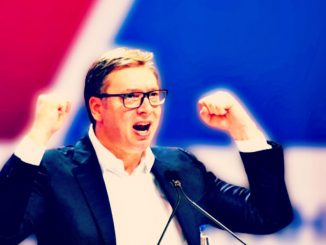
A supporter of the Serbian Progressive Party (SNS) lights a flare during a pro-government rally backing Serbian President Aleksandar Vucic’s policies and opposing months of student-led protests, in Belgrade, Serbia, April 12, 2025. REUTERS/Djordje Kojadinovic Purchase Licensing Rights
| Published April 14, 2025
Tens of thousands of supporters gathered in Belgrade over the weekend to back President Aleksandar Vučić amid escalating political tensions in Serbia. The pro-government rally, held in front of the National Assembly, was organized as a counter-response to ongoing anti-corruption protests that have challenged Vučić’s leadership.
The anti-government demonstrations began in late 2024 following a fatal railway station canopy collapse in Novi Sad that killed 16 people. The incident sparked public outrage over alleged government negligence and corruption, leading to widespread protests led by students, teachers, and farmers. These protests have drawn hundreds of thousands, marking the largest demonstrations in Serbia in decades.
At the pro-government rally, Vučić declared, “The color revolution is over,” referencing the term often used for movements aiming to overthrow governments through non-violent resistance. He accused foreign actors of orchestrating the unrest but provided no evidence for these claims. Vučić also presented five demands, including the restoration of order and peace, and called for legal action against individuals involved in what he described as vandalism and attacks during protests.
The rally featured support from regional allies, with Hungarian Prime Minister Viktor Orbán addressing the crowd via video message, expressing solidarity with Serbian patriots. The event was marked by heightened tensions, including activists attempting to block buses en route to Belgrade and clashing with police.
As Serbia navigates this period of political unrest, the government’s response to dissent, including detentions of protesters and crackdowns on independent media, has raised concerns about democratic backsliding. While Vučić maintains aspirations for European Union membership, his administration’s actions and close ties with Russia and China continue to draw scrutiny from international observers.
The outcome of these events could significantly impact Serbia’s political landscape and its relations with both regional neighbors and global partners.
Implications:
Here are the implications of the recent mass rallies and political unrest in Serbia involving President Aleksandar Vučić and accusations of a “color revolution”:
1. Democratic Stability in Serbia at Risk
-
The scale of both anti-government protests and pro-Vučić counter-rallies suggests Serbia is entering a volatile phase.
-
Clashes between protestors, police, and pro-government supporters could escalate, threatening public safety and testing the government’s tolerance for dissent.
2. Possible Democratic Backsliding
-
Vučić’s rhetoric about “foreign interference” and labeling protests as a “color revolution” mirrors tactics used by authoritarian regimes to discredit opposition.
-
Detentions of protestors and increased pressure on independent media signal a tightening grip on civil liberties and political opposition.
3. Serbia’s EU Path in Jeopardy
-
Ongoing crackdowns and erosion of democratic norms may hurt Serbia’s already-fragile path toward European Union membership.
-
Brussels is likely to apply diplomatic pressure or stall negotiations if political repression continues.
4. Regional Polarization Intensifies
-
Vučić’s alliance with Hungarian PM Viktor Orbán, who is also critical of liberal Western institutions, indicates a growing regional bloc of nationalist-leaning governments.
-
This alignment could isolate Serbia from pro-Western Balkan neighbors and deepen divisions in Eastern Europe.
5. Increased Geopolitical Influence from Russia and China
-
As Serbia’s ties with Western institutions fray, Vučić may lean more heavily on support from Russia and China.
-
This could further entrench Serbia in a geopolitical tug-of-war between East and West, complicating regional security and trade relations.
6. Domestic Polarization May Escalate
-
The clear divide between pro-government loyalists and opposition-led protestors raises the risk of internal instability.
-
A prolonged standoff could trigger early elections, a reshuffling of power, or even violent confrontations if not addressed through political compromise.
Overall Takeaway:
The mass mobilization in Serbia—both from opposition protestors and President Vučić’s supporters—reflects a nation on the edge of a political tipping point. As Vučić decries the unrest as a “color revolution” allegedly backed by foreign actors, concerns are mounting about the erosion of democratic norms and civil liberties. While he consolidates support through populist messaging and alliances with nationalist leaders like Hungary’s Viktor Orbán, Serbia risks alienating Western allies and jeopardizing its EU ambitions. The situation signals deeper instability, not just within Serbia’s borders but across a region increasingly caught between East and West.
SOURCES: THE GATEWAY PUNDIT – ‘THE COLOR REVOLUTION IS OVER’: Serbian President Vucic Gathers Tens of Thousands of Supporters in Massive Pro-Government Demonstration (VIDEO)
REUTERS – Thousands gather at pro-government rally in Serbia
AP NEWS – Serbia’s populist president demands order after months of anti-corruption protests shaking his rule




